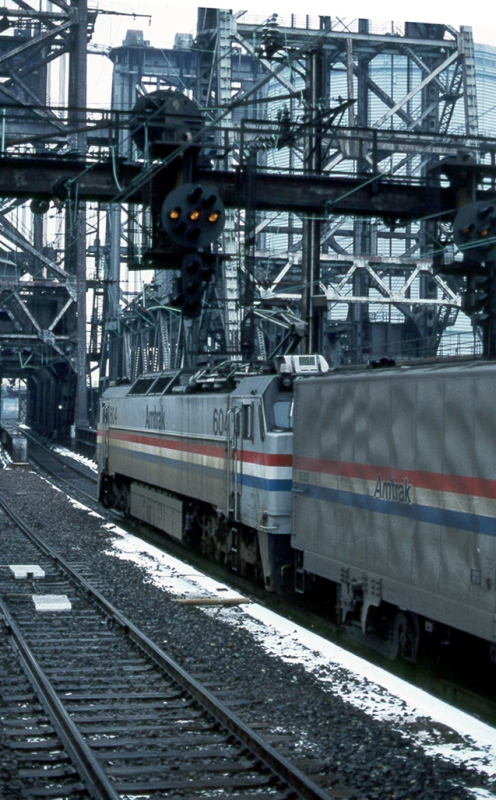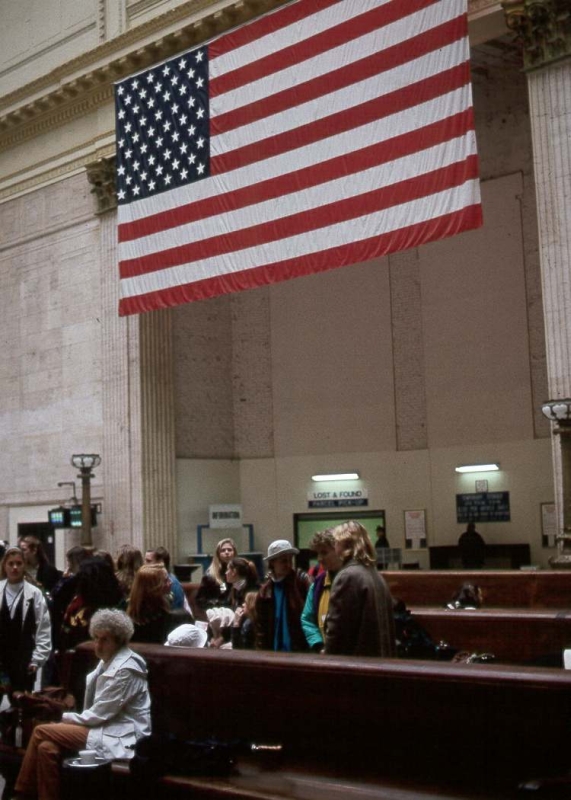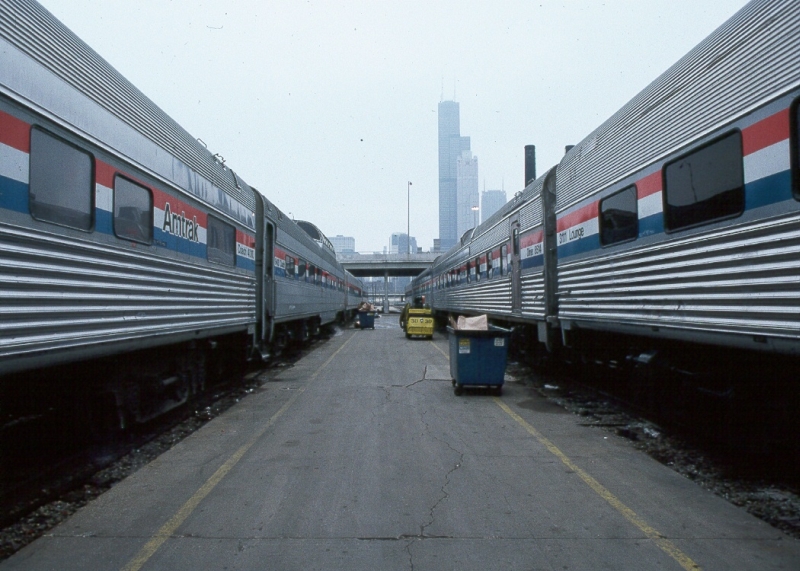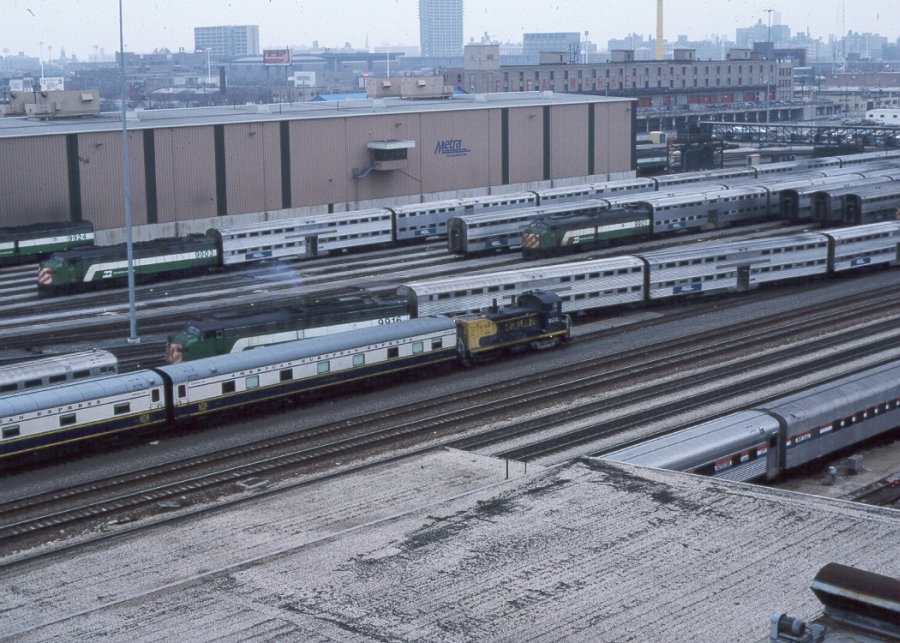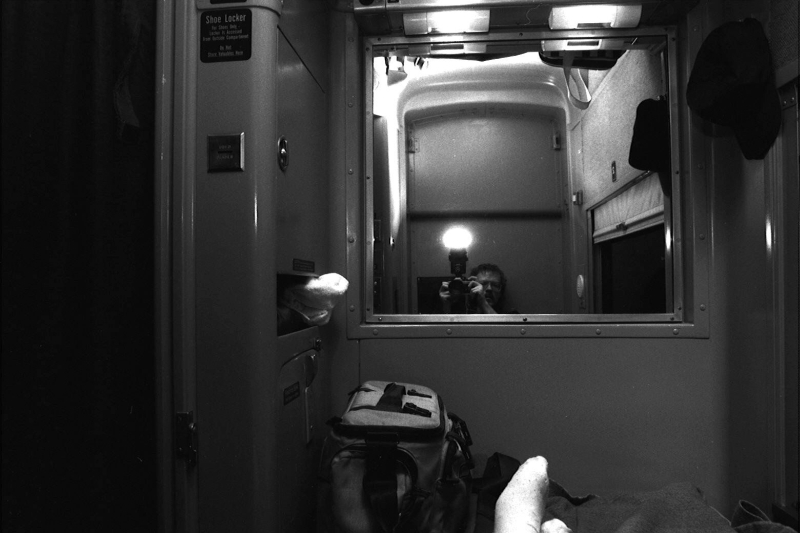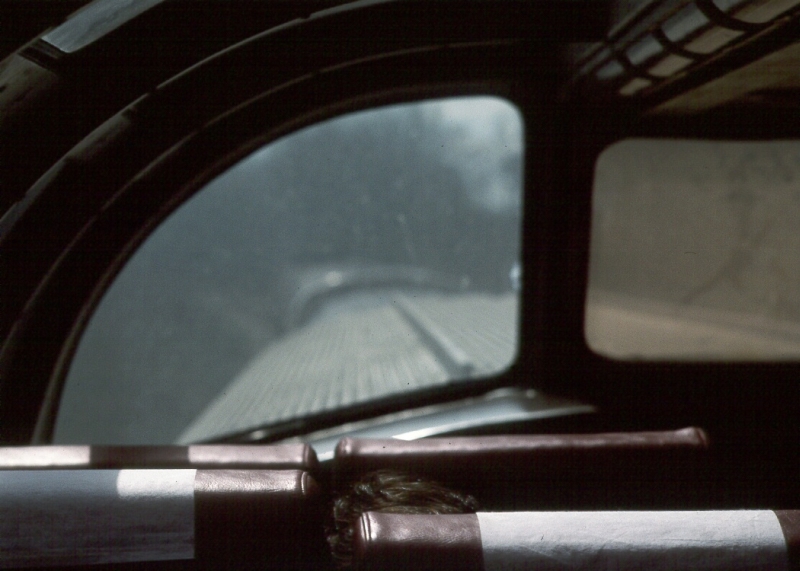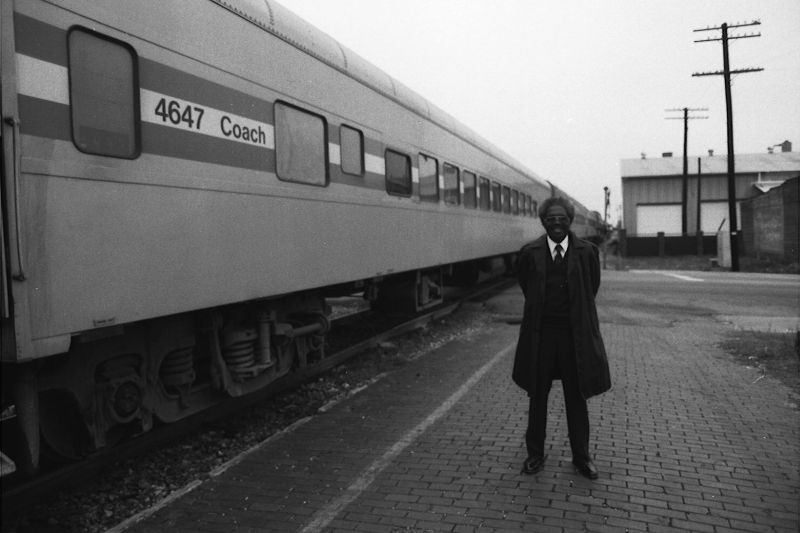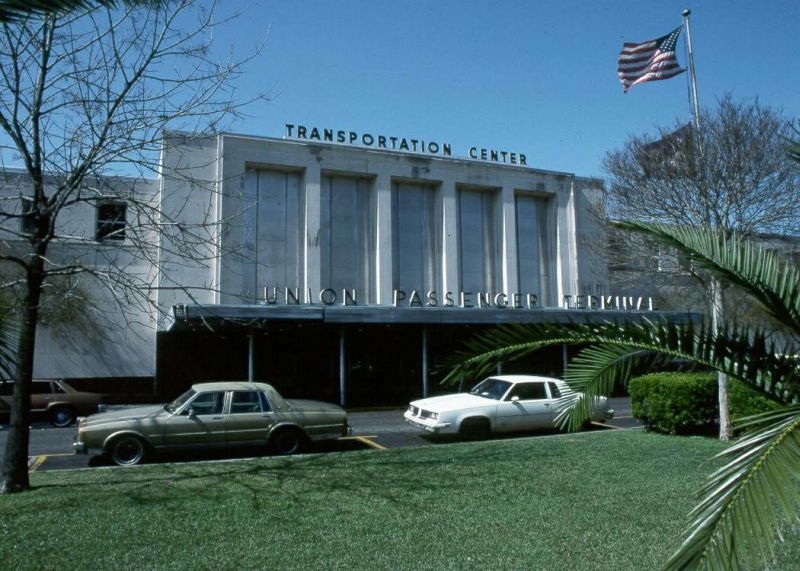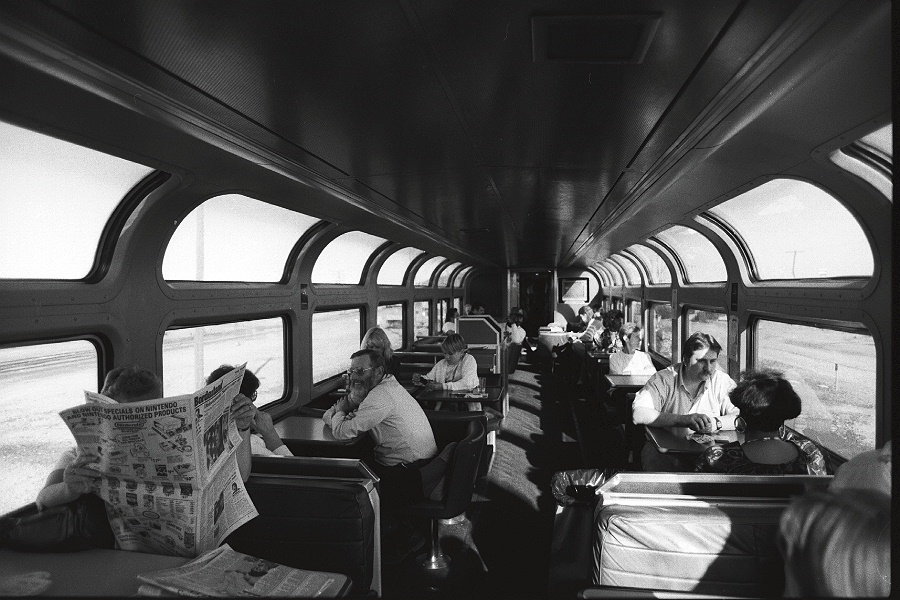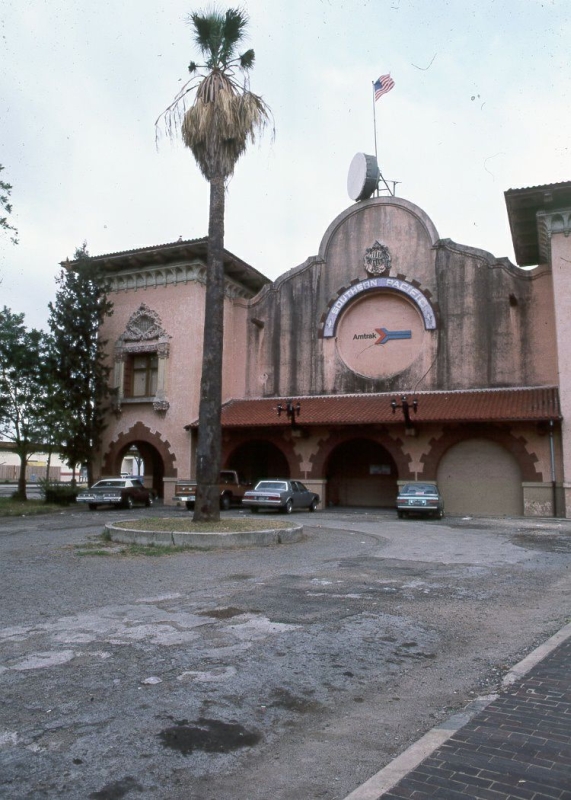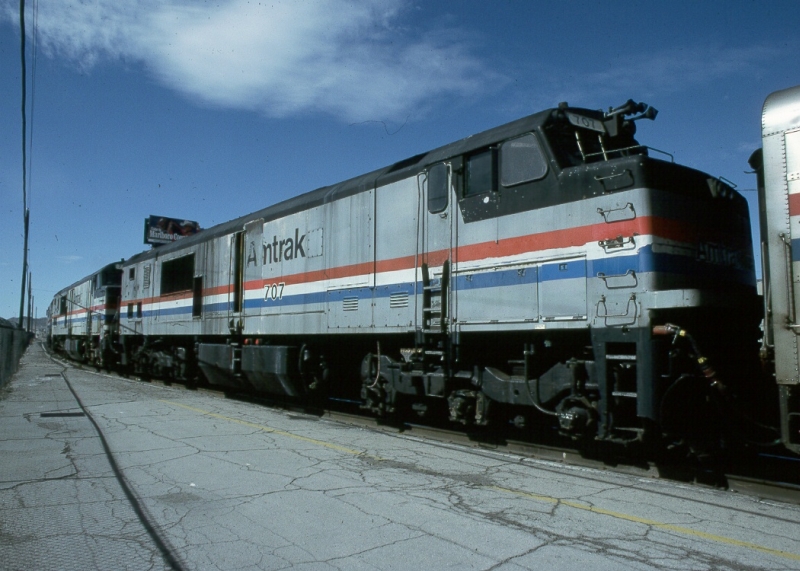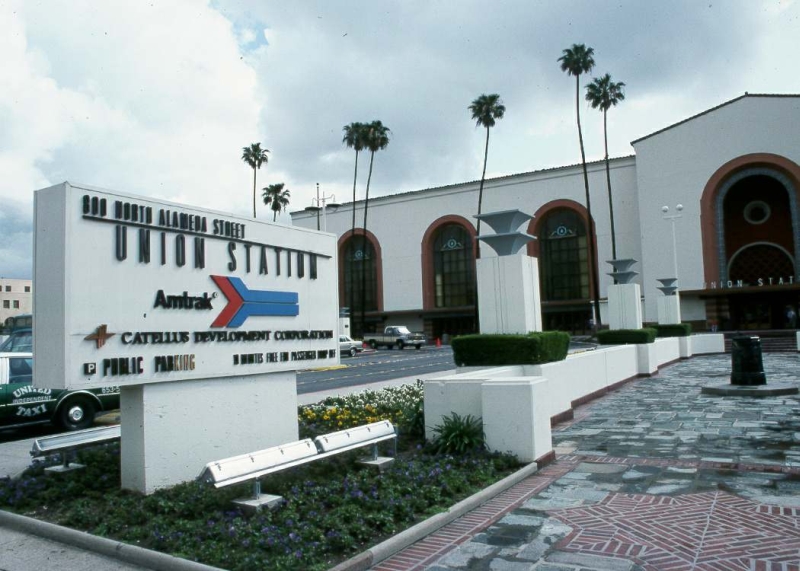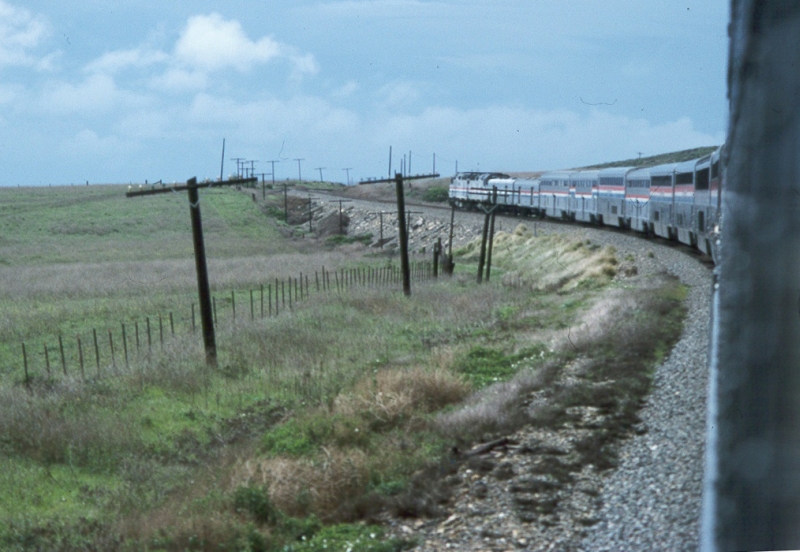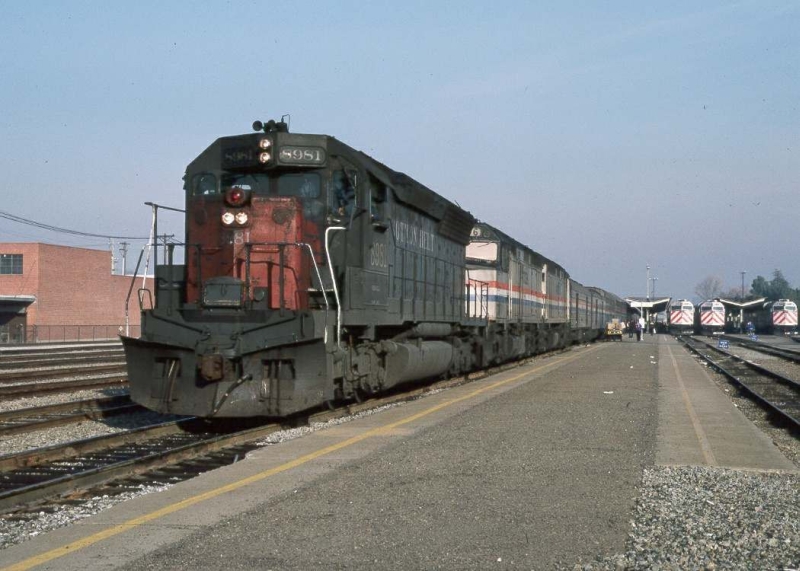By Ken Rattenne
I must confess that a wintertime train trip cross country made me nervous. I prepared myself mentally for delays, missed connections, and even train cancellations due to weather conditions or any other forces of chaos that seem to dog Amtrak's long distance trains. Yes, I was prepared for the worst. Nonetheless, I called a travel agengy frequented my folks and booked my itinerary comprising of four long distance trains, three of which I had never sampled before. (It should be noted that the travel agent I spoke with had never booked an Amtrak ticket and I found myself giving her instructions on what she should do). My transcontinental journey would start with an overnight train to Chicago from Newark aboard the Broadway Limited, then I would travel down America's spine on the City Of New Orleans, pausing for two days in Canton, Mississippi to visit a friend before proceeding on to New Orleans. A one-night layover would put me on the following day's Sunset Limited bound for Los Angeles where I would (hopefully) make a connection with the Coast.5tarlight for my final leg home (where my folks would meet me). I booked myself into sleeping
accommodations for the entire trip except for the brief day-trip between
Canton, Mississippi and New Orleans which saw me riding coach.
|
||||||||||||||||||||||||
|
THE BROADWAY LIMITED Train No. 41 - 906 Miles February 18, 1991
My day of departure from New Jersey was on President's Day, 1991. Train No. 41 arrived in Newark on-time with an E60 electric on the point (a nice break from the usual AEM-7). Upon boarding I found my car attendant polite and attentive as I quickly settled into my room. The train was equipped with two full sleepers and my slumber coach, plus, as is the usual Amtrak practice, a full diner and lounge coupled just ahead of my car. The lounge was an AmFleet car with one side designated for smoking and the other a "smoke free" zone (of course, it's impossible to keep smoke at one end of a car from drifting into the other). The thick bluish haze discouraged me from staying to soak up the ambience. However, those who smoke need a place to go, and after ordering a cocktail I retired to my room to await the call for dinner. Dinner In The Diner is always the highlight of any rail trip. Since slumber coach passengers are not considered First Class (this is the closest thing Amtrak has to a Second Class accommodation), I had no dinner reservation through my car attendant Re my fellow passengers in the sleepers behind me. In addition, my car's public address system was working only intermittently and failed altogether during the dinner hour: No one in my car (or the sleepers behind me) ever heard a dinner announcement, let alone a call to dinner after making a reservation in person with the dining car steward. Since our train was carrying a near capacity load, the dining car crew had their hands full with three scheduled sittings. Although I ended up with the last sitting, everything ordered from the menu was still available (how many times has a dining car run out of items during a final sitting?), and my meal was great. Dinner was made even more memorable by my table companion, an attractive Paramount Studios script writer, who made for interesting dinner conversation. The next morning's breakfast was also a winner, with the French Toast always a personal favorite. In spite of busy conditions, the dining car staff remained friendly and efficient and I found that my total experience on the Broadway was very positive. This was not the Amtrak I had experienced just four years ago. Philadelphia is where the company's Chicago-bound trains trade electric locomotion for diesel-electric. There was a minor delay of our departure as Philly's 30th Street station was congested with trains and passengers returning home from the three-day holiday. Upon listening to my scanner, I heard Philly's stationmaster and the conductor of No. 175, the Minute Man, argue over whether they could leave with standees in the car vestibules. Irritation was in the air! We departed eight minutes late. Speeding through the dark
over the Pennsylvania countryside, we more than made up our lost time and
by Ohio were back on the advertised. In general, No. 41 operated on time
along most of its schedule and our arrival in Chicago was 10 minutes early,
rolling to a stop at 9:19 am.
CHICAGO February 19, 1991
To make a connection between the Broadway Limited and the City Of New Orleans, a layover of over eight hours is necessary. The southbound City, Train No. 59, departs Chicago daily at 6:45 PM for New Orleans, and I found myself actually wishing that the Broadway would have been late so as to cut down on the length of my wait. In February of 1991, the remodeling of Chicago's Union Station was well underway and the station's finished main foyer was impressive indeed. For passengers who have lengthy layovers, Union Station offers a service that allows you to leave your tagged bags at a manned counter for as long as need be. Luggage is not locked up, but no one may access the luggage area without a claim ticket. Amtrak also has a first class lounge for sleeping car passengers (excepting slumber coach patrons, of course) that offers a secluded alcove away from the hubbub of the main station. While I like my privacy, I found the lounge a bit sterile and ended up waiting in the main passenger lounge where the "rank and file" travelers were biding time. If you like to people watch, this is a good place to be, plus passengers seem more willing to converse than in the First Class lounge. Since I had so much time on my hands, I had pre-arranged with Amtrak’s Public Relations office in Chicago to tour their coach yard. I took a taxi to the 14th Street Maintenance Facility where I met with my host, Assistant Facility manager Leonard May, for the morning's tour. Part of my “walkabout" was a request to find and inspect the trainset I was to ride later in the evening, and my guide, General Car Forman Tom Kelly, accommodated me by locating No. 59's cars. It’s not very often a passenger gets to look over his accommodations before boarding, and I jumped at the opportunity to do so. Carmen and car cleaners were busy inspecting and cleaning each car, knowing that only a few hours remained before their charges would be moved to the train sheds of Union Station. After spending about four
hours at Amtrak's hub facility, I returned to Union Station to finish waiting
out the departure of my train.
CITY OF NEW ORLEANS TRAIN NO. 59 924 Miles February 19 & 20, 1991
The City Of New Orleans is an overnight train traveling the breadth of the country through the heart of Middle America. While the train's namesake city New Orleans is not a thriving Amtrak hub, it does act as a pivotal gateway between the South, the West and the midwest, allowing passengers to connect with either the Sunset Limited, the Crescent, or a plethora of eastern trains in Chicago. I was booked into one of No. 59's roomettes, and after sleeping aboard a slumber coach, my new compartment actually seemed spacious (I like to say that a roomette is only slightly bigger than a 'closette'). Kathy, my car attendant, had a thick Southern drawl (I would have been disappointed if she hadn't) and was both cheerful and helpful to each passenger she encountered. Sleeping cars have always been a special place to me: Boarding one at night to find your bed turned down and the warm glow of the room lights pouring from each open compartment imparts a feeling of snugness; its like being tucked into bed by your mom (though I know of no car attendants who have offered me that favor). Departure was on-time, but we dallied at the station's yard throat due to a stuck switch. Nonetheless, we lost only 15 minutes, then were on our way whisking through southern Illinois. I found Amtrak's City to be an unusual train. It appears to have an unofficial second class status as far as equipment and services are concerned. (I was told by Tom Kelly that this train is considered the filthiest of all Chicago-assigned trains. It typically takes more man-hours to ready No. 59's trainset each day because of minor vandalism to equipment - plugged toilets are common - and passenger apathy to cleanliness prevelant.) That night's train had an unusual consist. Unlike the Broadway, it was not equipped with a full dining car - it did, however, offer a former Northern Pacific dome coach, an amenity I had not experienced on Amtrak since 1981. The lounge car, No. 3108, was a Heritage Fleet car built as a lunch-counter car for Santa Fe in 1948. For our dining pleasure, No. 59 featured a Horizon Fleet dinette, and the microwaved dinner and next morning's breakfast were well below my standards for palatable food. I was glad first class passengers received free meals -- those two were not worth paying for! Nighttime in a dome car is another of my favorite rail experiences, and since the Superlinerization of western trains (and the discontinuance of the Rio Grande Zephyr) my dome experiences have been limited to private cars. But on the City I was able to once again experience the silent thrill of a nighttime dome ride. After my dining experience, I quickly migrated to the darkened and mostly empty short dome of car 9405. It's wonderful to sit again in the quiet darkness and watch emerald green target signals turn to ruby red as they slide gracefully by my elevated vantage point. It reminded me of my first dome ride aboard the Coast Starlight between San Jose and Oakland, California in 1978 while on a USA Railpass trip (remember those?). I was awed by the experience of that night only to have it surpassed later in my trip by a moonlit crossing of the Great Salt Lake on Southern Pacific's Lucin Cutoff aboard the old San Francisco Zephyr. On No. 59 I felt reunited with an old friend. Did I say quiet darkness? What was that noise? Nestled in the rear seat at the back of the dome was a passenger snoring so loud he could have awakened Casey Jones from his grave. After a bit, fellow passengers began drifting up to join me, whispering in hushed tones or simply taking in the black night. This finally urged the slumbering passenger to migrate below to his assigned coach seat. It's ironic that one of my trip's highlights was a nighttime ride aboard the City Of New Orleans in the middle of southern Illinois. Our arrival the next morning
at Canton, Mississippi, was ten minutes early, but my friend Pati was there
nonetheless to greet me!
CITY OF NEW ORLEANS TRAIN NO. 59 February 22, 1991 Two days later I'm again on Canton's brick depot platform under leaden skies awaiting another No. 59. This would be the shortest leg of my cross country trip and I was anxious to see if the consist of this day's City would be similar to my first encounter with No. 59. It was. If I was ten minutes early into Canton two days ago, it was negated by today's No. 59 being twenty minutes late. Just out of Durant, the last station up the line, the train lost it's HEP. We sat in Canton while the train crew attempted to regain hotel power to the train. When I asked a crew member about the nature of the problem he was polite and informative and told me they suspected the cables. Not at all like the surly Burlington Northern conductor I encountered on the North Coast Hiawatha in 1979 while traversing Stevens Pass in a blizzard. Now there was a man I truly wanted to throw off the train. Luckily, the City's crew knew their stuff and the consist soon came back on-line with lights, heat and air conditioning (for the dome). Kudos to those trainmen.
One minor irritation: At Hammond, Louisiana, 53 miles north of New Orleans, the dinette and lounge crews (this train's lounge was an AmFleet II car) shut down their respective cars without making any prior announcements to the passengers. On my entire cross country trip, this was the single incident that illustrated Amtrak has not yet purged all the bad apples from its onboard crew ranks. While the sleeping car attendants were first rate, my coach attendant was usually no where to be found, and the dinette and lounge personnel seemed aloof and disinterested, there only for their own convenience. Our entry into the Crescent
City was ontime by Amtrak standards (within 20 minutes of the advertised).
However, it is one loooong walk down an open platform to the station, and
not one of the usually pervasive Smart Carts were in evidence (though there
were racks for them). Once inside the modern-looking depot it is a short
walk to the front of the station. I had two cab drivers turn me down as
a fare -- a first in my travel experience -- before I found a cabby with
a Caddy to take me to my hotel.
THE SUNSET LIMITED TRAIN No. 1, 2,033 Miles February 23, 1991
When I booked this trip with my travel agent (who said she had never booked anyone aboard Amtrak before), I jokingly stated, "Do you know of an airline with a flight No. 1?" She admitted that she drew a blank. Thus I touted the long history of the Sunset Limited. In my case, it necessitated an overnight stay in New Orleans (there are worse places to layover), as I did not want to risk a close connection between the City and the Sunset. There is but an hour between the arrival of one and the departure of the other. Naturally, my previous day's No. 59 was early - but today's No. 59 had not arrived by the time No. I left the bumper post on the Sunset New Orleans is where Heritage Fleet gives way to Superliners, dome cars to Hilevel lounges, bayous to rolling plains. As a bonus, the private car Intrepid was bringing up the markers of today's No. 1 - all the way to Houston. Our departure was five minutes late, at 2:05 PM, due to an electrical problem with one car. On the point of today's train the power bureau decided to assign three units, two aging G.E. P30CHs (lovingly known as "Pooches") and a single F40 to lead. One of the first highlights of No. 1's journey is leaving New Orleans on a graceful crossing of the 4.4 mile Huey Long Bridge, which is high enough to give the passenger the feeling of flying over the city. I was booked into an economy bedroom, which is the largest accommodation within the financial reach of a single traveler. It is significantly larger then a roomette, and is a veritable palace when compared to a slumber coach room. Of the three types of room accommodations sampled, the economy bedroom is by far my favorite. The rooms are quiet and comfortable, giving the passenger the choice of piped music (we had Dixieland jazz playing while awaiting departure from NOL) or silence. These rooms are bigger, yet with their plethora of reading lights and night lights, are cozier than their eastern counterparts. The Economy Bedroom's one drawback, of course, is the lack of a of commode, sacrificed to lend more room to each compartment. However, I have found over the years that a trip down the corridor, even in the middle of the night, is not a bad thing. When you gotta go, you gotta go! Much has been written over the years concerning Sunset horror stories. Most of the train's route is over desert terrain and anything that can go wrong has gone wrong. Considering the Sunset's tri-weekly status it seems to have more than its share of problems. Everything from lost HEP power to disabled locomotives, and even floods have been known to delay the train. I was scheduled to connect the same day as my arrival with the Coast Starlight, said connection allowing only three hours leeway. Would I make it or would the forces of chaos combine to delay my train beyond hope? As former Amtrak public relations man Art Lloyd likes to say, "That's part of the adventure of rail travel! " Only 127 miles out of New Orleans No. we had already lost a half hour. Surprisingly, our arrival at Houston was fifteen minutes early, allowing plenty of time to remove the Intrepid. At San Antonio we added two coaches and a sleeper from the Texas Eagle, departing in the middle of the night as an 11-car train. No. 1 is very well patronized, with a large number of passengers boarding last night both in Houston and San Antonio, plus the addition of the three cars of passengers from the Texas Eagle. To my delight, our lounge car was not the typical Superliner lounge but a former Santa Fe Hilevel car. During the ten years I have traveled in Superliners, I had yet to get one of these gems in my consist as lounge car (the Reno Fun Train used to operate with one that had all the seats removed to make a dance floor, leaving only the bar). I found this car to be more fun to ride in then its successor car. The on-train movie that night was "Bird On The Wire" with Mel Gibson, and the lounge was just about half full of viewers. The next night's movie was "The Gods Must Be Crazy Part II." I applaud Amtrak for this innovation; unlike the airlines, the passenger does not have to pay for the "privilege" of watching a film and listening to it through tinny and uncomfortable headphones. Nor is the passenger who does not wish to watch have to endure the distraction of seeing a movie with no sound. Amtrak's movies are free and if you don't like what's playing, you can either leave or go to the lower level lounge. Amtrak’s long haul trains carry the same basic menu as their eastern counterparts - and the food on the Sunset was wonderful compared to the microwaved rubbish offered on the City Of New Orleans (though the dinner rolls were sometimes a bit on the stale side). In general, this crew stayed friendly and service-oriented through the entire trip, in spite of the increased passenger load as the train traveled west. First Class passengers receive a morning newspaper. On the Broadway it was USA Today - a paper that I have also received on the California Zephyr (I did not get a paper on the City Of New Orleans!). My first morning out on the Sunset, though, I received a pleasant surprise: The Sunday edition of San Antonio's daily newspaper. Now here was a paper you could sink your proverbial teeth into. Its size illustrated a respectable a metropolitan newspaper with plenty of news ("ALLIES OPEN GROUND WAR! referring to the opening round of the Gulf War) and entertainment. It made you want to curl up in your bed and spend the day reading; it also gave the passenger a sense of place - Texas. And we were still on time! My travel experience during the second day aboard the Sunset was as pleasant as the first. My car attendant was polite, helpful and knew her job well, and the onboard crew chief gave a running commentary on scenic wonders and curiosities along this historic Southern Pacific route. Most intereswting was our entry into Big Bend country, where we passed through Alpine then ascended Paisano Pass, the highest point on the Sunset Route. The last time I had been in this area was in 1984 when Jon Porter and I chased former SP 4449 between El Paso and Alpine with the New Orleans Daylight. The Sunset route guide issued by Amtrak and found in all First Class complimentary packets, makes following your progress more interesting, especially in areas totally unfamiliar to the passenger. In addition, the onboard crew conducted a Sunset trivia game, the answers available in the route guide or from commentary given by the crew chief. At El Paso (Amtrak milepost 1178) the train is serviced and passengers are encouraged to detrain and stretch their legs in the warm Texas sun. Since I had a lower level room and window I decided to do a little wash and touch up to improve my view. I no sooner began wiping down my window when two other patrons with lower level windows on the Texas Eagle sleeper followed suite. The rest of the sleeping car passengers looked at us with envy - we had clean windows - they didn't! While racing across New Mexico, my scanner revealed the train crew having a little fun. Our track speed was 76 mph, with SP allowing a maximum of 79 mph. The conductor asked the engineer why we weren't doing 79 and he jokingly replied, "Hell, I keep trying to do 90 - but we always slow down!." Later, a trainman asked the engineer to "...be sure and release those parachutes..." to help slow the train for our stop at Deming, NM - the engineer's reply: "No sweat." That evening we picked up a fourth locomotive and a four-car trainset that was on display in Phoenix, making for an unusually long wintertime consist of 15 cars. This time the crew joked about having enough horsepower for the climb over Beaumont Hill (in California). Our arrival at Los Angeles
Union Passenger Terminal was - early! In fact it was nearly a half hour
early. My layover at LAUPT gave me time for breakfast at the station cafeteria
before boarding the
Coast Starlight for the final leg of my journey.
THE COAST STARLIGHT TRAIN NO. 14, 423 miles February 25, 1991
The Coast Starlight is truly a California train (at least No. 14 is). The atmosphere aboard No. 14 is subtlety different than any of the other trains I have ridden. Lots of college students and young people regularly ride the Starlight, and its not uncommon to find a party-like atmosphere in the coaches. Aside from my lunch (there is no breakfast service upon departing L.A.) I spent most of my time conversing in the lounge. It is so easy to strike up a conversation on this train; no one feels their privacy is being violated. It's like being on a rolling cocktail party. And now that smoking is confined to the lower level, non-smokers like myself are able to utilize the lounge as it was intended: As a social gathering place to meet fellow passengers. (On my last Superliner trip - aboard the CZ in 1987- 1 could tolerate the smoke in the lounge car only long enough to purchase a snack or cocktail, which was unfortunate while traversing Rio Grande's Tunnel District just outside of Denver). The Starlight's
arrival at my destination city of San lose was ten minutes early! Thus
completed my first transcontinental Amtrak journey.
|
||||||||||||||||||||||||
|
EPILOG Reviewing my journals during 2005 I realized that while much had changed since 1991, much has also stayed the same. In 1990 and 1991, it seems Amtrak has listened to the passenger. While there are still occasional bad apples on some train crews, the company has implemented many service improvements. With an improved menu, re-trained chefs, a smoking policy that benefits the majority of passengers, and the improved attitude of onboard personnel, Amtrak has indeed come a long way. Amtrak's trains still have on-time performance issues outside of the NEC (I consider the on-time performance of my entire transcontinental journey to be atypical), but much of that can be blaimed on host railroads. Of the 4,319 mile I traveled on my cross-country rail trip, only the City Of New Orleans stands out as a service anomaly. I got the feeling it was a train Amtrak doesn't know what to do with. While I would like to shake Amtrak President Graham Claytor's hand, I would also like to whisper in his ear that trains like the City need as much attention to detail as a Broadway Limited or California Zephyr. Still, my benchmark for a good vacation - and this trip across the country was indeed my vacation - is whether I come back home feeling rested and relaxed and have a boatload of film to process. Upon my return home to Modesto, in the Central Valley, I felt it was time and money well spent Would I do it again? In a minute! |
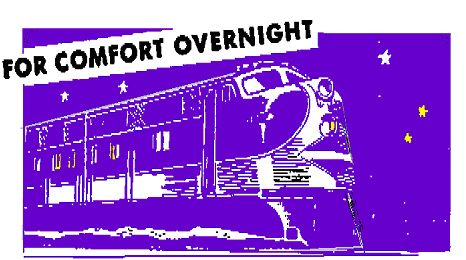 In
February of 1991 I was scheduled to present a multimedia slide show at
the Eastrail photo exposition in New Jersey. While I would need to fly
to my destination from sunny California, I decided it would be great fun
to return home by train. At the time I was still actively involved in writing
monthly Amtrak columns for magazines such as CTC Board, Passenger
Train Journal and Pacific Rail News (the latter two now defunct).
Thus I was doubly curious as to state of "training" at the end of Amtrak's
second decade.
In
February of 1991 I was scheduled to present a multimedia slide show at
the Eastrail photo exposition in New Jersey. While I would need to fly
to my destination from sunny California, I decided it would be great fun
to return home by train. At the time I was still actively involved in writing
monthly Amtrak columns for magazines such as CTC Board, Passenger
Train Journal and Pacific Rail News (the latter two now defunct).
Thus I was doubly curious as to state of "training" at the end of Amtrak's
second decade.
